Complete Solutions to Breathing And Exchange Of Gases of chapter BREATHING AND EXCHANGE OF GASES of Class 11 book with complete answers and questions
| Class 11 | BIOLOGY |
| Chapter | BREATHING AND EXCHANGE OF GASES |
| NCERT FINGERTIPS | Breathing And Exchange Of Gases |
| Number Of Questions | 100 |
| Academic Year | 2023-24 |
Statement 1 : Respiration is most efficient in the insects, among the invertebrates.
Statement 2 : In the insects, air is carried directly to the cells by tracheoles.02:54View SolutionRead the given statements characterizing certain types of animals. Select the option which correctly exemplifies each of these types.
(i) Animal having external gills
(ii) Animal having internal gills
(iii) Animal showing tracheal respiration
(iv) Animal revealing buccopharyngeal respiration03:45View SolutionMatch column I with column II and select the correct option from the given codes.
`{:("Column I",,"Column II"),("(Animals)",,"(Respirartory structures)"),("A. Pigeon " ,,"(i) Book gills"),("B. Scorpion",,"(ii) Pharyngeal wall"),("C. Planaria",,"(iii) Lungs"),("D. Earthworm",,"(iv) Gilles"),("E. Spiders",,"(v) Book lungs"),("F. King crab",,"(vi) Body surface"),("G. Prawn",,"(vii) Skin"),("H. Labeo",,):}`04:33View SolutionWhich structure of man is similar to spiracle of cockroach?
02:16View SolutionWhich of the following option is incorrect about the larynx (sound box) ?
04:16View SolutionWhich of the following structures close the glottis during swallowing to prevent the entry of food wind pipe
02:31View SolutionIn man and mammals, air passes from outside into the lungs through
03:25View SolutionStudy the given figure of respiratory passage carefully and identify the parts labelled as A, B, C, D and E.
 02:28View Solution
02:28View SolutionMammalian lungs have an enormous number of minute alveoli (air sacs). This is to allow
01:40View SolutionThe given figure shows the diagrammatic view of human respiratory system. Identify A, B, C and D.
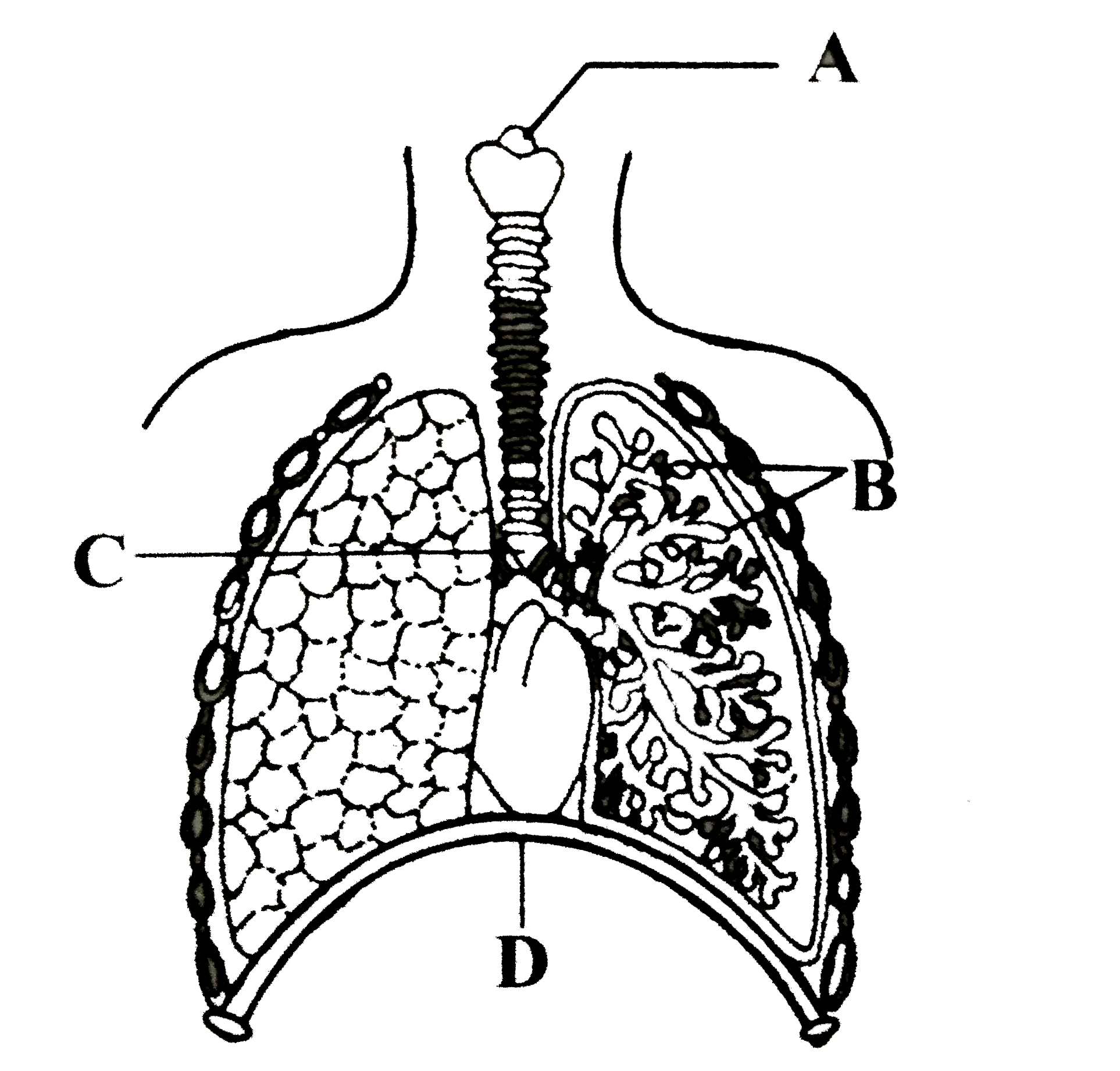 04:48View Solution
04:48View SolutionThe given figures are of human larynx, front view (i) and vertical section (ii).
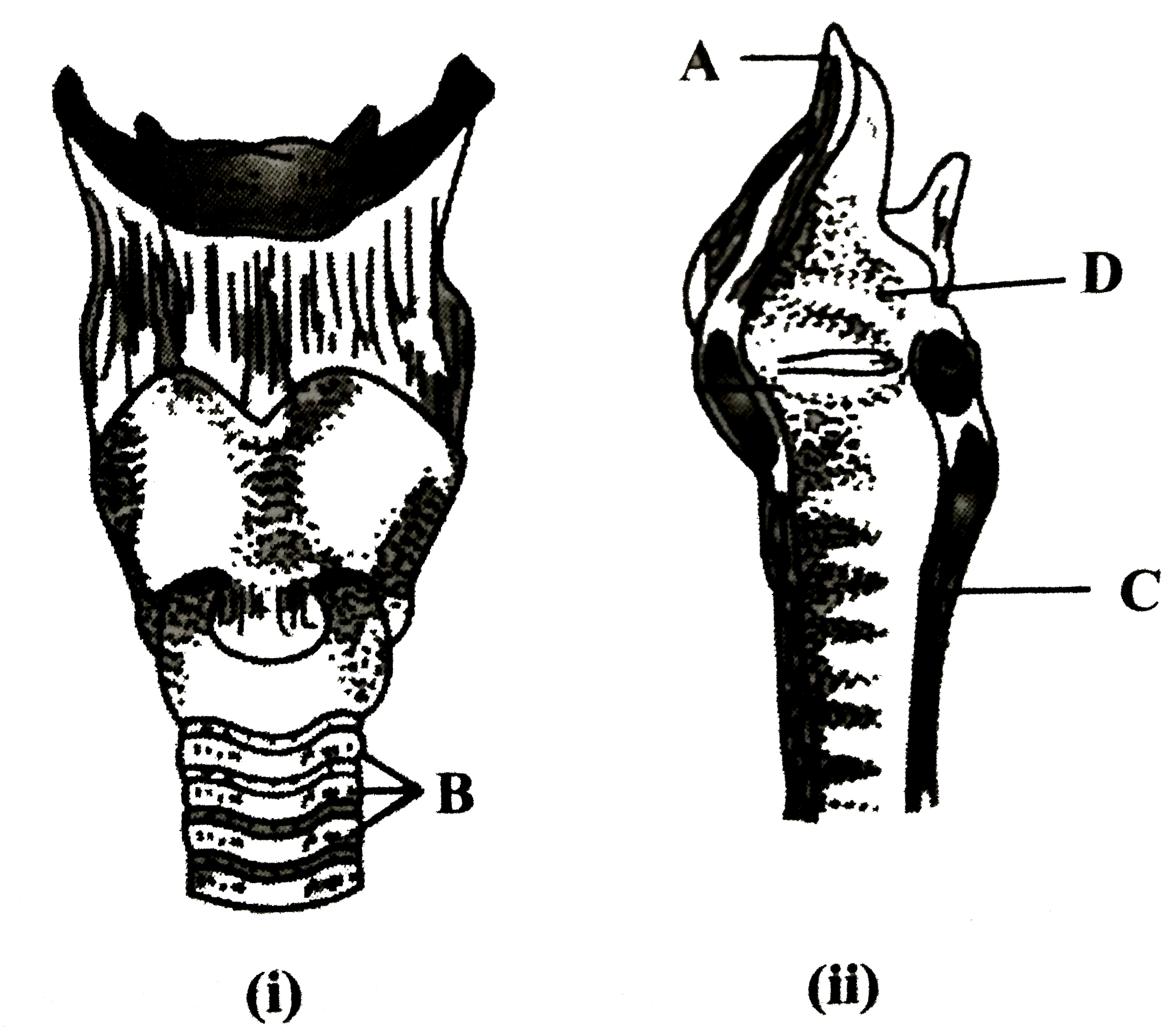
Identify the labelled parts A to D.02:57View SolutionLungs are enclosed in
01:58View SolutionThoracic chamber is formed dorsally by the `overset((i))"____"`, vertrally by the `overset((ii))"____"`, laterally by the `overset((iii))"____"` and on lower side by the dome shaped `overset((iv))"____"`.
Select the correct option to complete the above paragraph.01:43View SolutionGiven below is a list of different steps (i-vi) involved in respiration.
(i) Utilisation of `O_(2)` by the cells for cataolic reactions.
(ii) Transport of gases by the blood.
(iii) Pulmonary ventilation by which atmospheric air is drawn in and `CO_(2)` is released out.
(iv) Release of resultant `CO_(2)`.
(v) Diffusion of `O_(2)` and `CO_(2)` between blood and tissues.
(vi) Diffusion of gases (`O_(2)` and `CO_(2)`) across alveolar tissues.
Select an option which has correct sequence of all the steps.03:31View SolutionInspiration occurs when there is a negative pressure in the lungs with respect to atmospheric pressure. This negative pressure is achieved when
02:18View SolutionStatement 1 : Mammals can eat while breathing.
Statement 2 : Mammals have negative-pressure breath-ing.02:59View SolutionThe ventilation movements of the lungs in mammals are governed by
02:36View SolutionFill up the blanks in the following paragraph by selecting the correct option.
The movement of air into and out of the lungs is carried out by creating a (i).____ between the lungs and the atmosphere. Inspiration can occur if intra-pulmonary pressure is (ii).____ Expiration takes place when the intra-pulmonary pressure is (iii).____ than the atmospheric pressure. Expiration takes place when the intra-inspiration is initiated by the (iv).____ of diaphragm which (v).____the volume of thoracic chamber in the antero-posterior axis.02:51View SolutionWhich of the following sequenes is correct to intite inspiration ?
(i) the contraction of external intercostal muscles raises the ribs and sternum
(ii) Volume of thorax increases in the dorso-ventral axis
(iii) intrapulmonary pressure decreases
(iv) Diaphragm contraction
(v) Air rushes into lungs
(vi) Volume of thorax increases in the anterior-posterior axis02:37View SolutionWhich of the following changes occur in diaphragm and intercostal muscles when expiration of air takes place ?
05:13View SolutionDuring expiration, the diaphragm becomes
01:08View SolutionExhalation is the process of expulsion of air through the respiratory tract. Which figure illustrates the process of exhalation ?
01:53View SolutionThe given figure illustrates the changes in lung volume during the process of breathing.
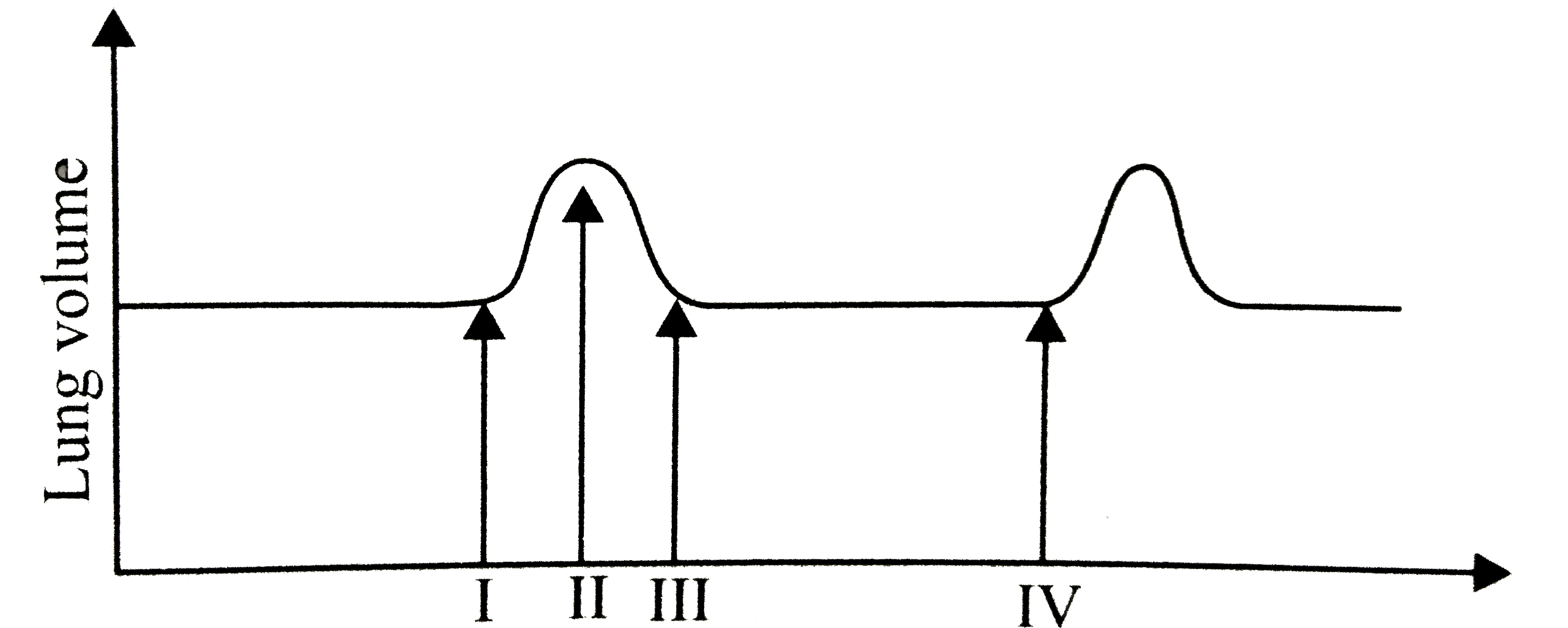
The changes from II to III indicates the02:43View SolutionAccoding to Boyle's law, the product of pressure and volume is a constant. Hence,
01:54View SolutionWhich of the following statements about the mechanism of ventilation/breacthing is incorrect ?
03:51View SolutionA person breathing normally at rest, takes in and expels approximately half a litre of air during each respiratory cucle. This is called
03:38View SolutionWhich one of the following statements is incorrect ?
View SolutionListed below are four respiratory capacities (i-iv) and four jumpled respiratiory volumes of a normal human adult.
`{:(,"Respiratory volumes and capacities","Volume of air"),((i),"Residual volume","1200 mL"),((ii),"Vital capacity","4500 mL"),((iii),"Inspiratory reserve volume","2500 mL"),((iv),"Inspiratory capacity","3500 mL"):}`05:16View SolutionComplete the following sentences by selecting the correct option.
(A) Inspiratory capacity `(IC) = overset((i))"_________" + IRV`
(B) `overset((ii))"________" = TV + IRV + ERV`
(C) Funcational residual capacity `(FRC) = ERV + overset((iii))"_________"`04:20View SolutionConsider the following statements each with one or two blanks.
(i) Left lung has `overset((1))"______"` lobes and right lung has `overset((2))"_________"` lobes.
(ii) Prawn respires with `overset((3))"________"` and insects with `overset((4))"________"`.
(iiii) Amount of air inhaled and exhaled with maximum effort is referred to as the `overset((5))"_______"` of the lungs.
Fills up the above blanks by selecting the correct option.02:42View SolutionConsider the following statements each with two blanks.
(i) Actually, only about `overset((1))"_____"` mL of air enters the lungs alveoli for the exchange of gases. The remaining fills the respiratory passage and is termed `overset((2))"_____"`.
(ii) The amount of air which one can inhale with maximum effort and also exhale with maximum effort is termed as `overset((3))"_____"`. It is about `overset((4))"_____"` in normal adult person.
(iii) During normal quiet breathing, on an average, approximately `overset((5))"_____"` mL of air is inspired or expired by adult human male in each breath. It is termed as `overset((6))"_____"` volume.
Which of the following options gives the correct fill ups for the respective blanks numbers from (1) to (6) in the above statement ?03:54View SolutionThe inspiratory reserve volume `+` tidal volume `+` expiratory reserve volume is the same as
05:43View SolutionVital capacity of lungs is
03:21View SolutionAfter forceful inspiration, the amount of air that can be breathed out by maximum forced expiration is equal to
02:40View SolutionMatch column I with column II and select the correct option from the given codes.
`{:(,"Column I",,"Column II"),(A.,"Tidal volume",(i),2500-3000 mL "of air"),(B.,"Inspiratory reserve volume",(ii),1000 mL "of air"),(C.,"Expiratory reserve volume",(iii),500mL "of air"),(D.,"Residual volume",(iv),3400-4800mL "of air"),(E.,"Vital capacity",(v),1200mL "of air"):}`.05:29View SolutionMatch column I with column II and select the correct option from the codes given below. `{:(,"Column I",,"Column II"),(A.,"TV + ERV",(i),Expiratory Capacity),(B.,"RV + ERV + TV + IRV",(ii),"Total Lung Capacity"),(C.,"ERV + RV",(iii),"Functional Residual Capacity"):}`.
04:52View SolutionConsider the following four statements (I - iv) and select the correct option stating which ones are true (T) and which ones are false (F).
(i) Formation of oxyhaemoglobin occurs on alveolar surface.
(ii) During gaseous exchange the gases diffuse from high particle pressure to low partial pressure.
(iii) Carbon dioxide cannot be transporteed width haemoglobin.
(iv) Earthworm respires through parapodia.03:51View SolutionThe exchange of gases in the alveoli of the lungs takes place by
01:54View SolutionThe given figure shows the diagrammatic represtation of exchange of gases at the alveolus and the body tissues with blood and trasport of oxygen and carbon dioxide. Identify the blood vessles A to D.
 03:04View Solution
03:04View SolutionConsider the following statement each with two blanks.
(i) Diaphragm contrects to help in `overset((1))"_____"` while the contraction of abdominal muscles help in `overset((2))"_______"`.
(ii) Vital capacity of trained atheles is `overset((3))"______"` than that of non-athletes while the vital capacity of non-smokers is `overset((4))"______"` than that of smokers.
Which of the follwoing options gives the correct fill ups for the respective blanks numbered from (1) to (6) in the above statements ?04:44View SolutionWhich of the following would have the same `O_(2)` content?
03:13View SolutionWhat is the approximate normal composition of alveolar air ?
02:21View SolutionThe `CO_(2)` content by volume, in the atmospheric air is about
01:07View SolutionAmong the following the partial pressure of oxygen is maximum in
01:37View SolutionIn lungs, the air is separated from the venous blood through
02:18View SolutionThe factor which does not affect the rate of alveolar diffusion is
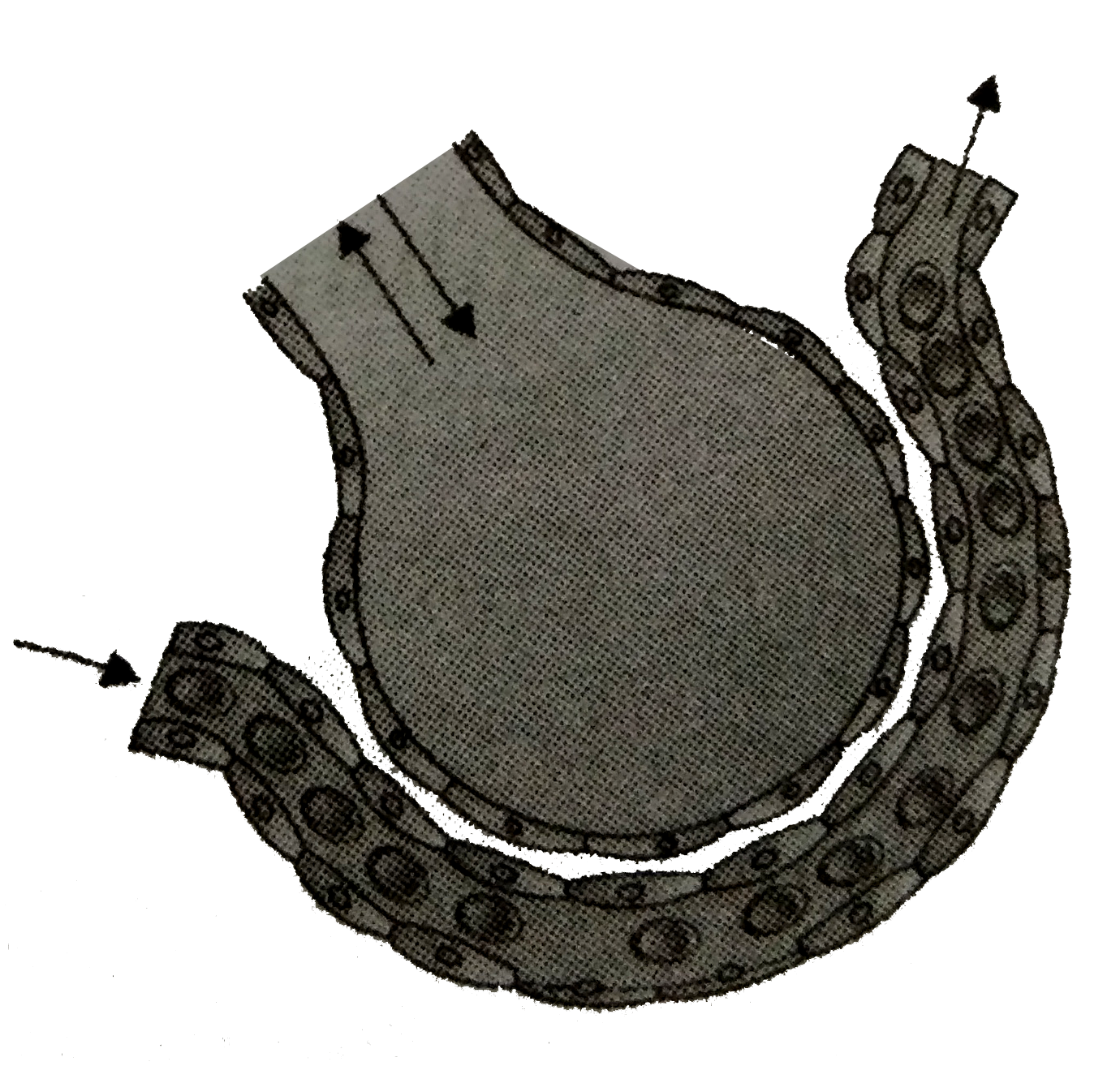 01:52View Solution
01:52View SolutionBesides RBC, blood plasma also carries `O_(2)` in solution. The percentage is
01:17View SolutionWhich of the following statement is correct?
03:06View SolutionWhich of the following statement is true about RBCs in humans?
01:58View SolutionThe carbon dioxide is transported via blood to lungs mostly
02:22View SolutionBlood carries the `CO_(2)` in three forms. The correct percentages of `CO_(2)` in the these form are
02:08View SolutionBluk of oxygen diffuses from the plasma into the red blood corpuscles where it joins loosly with `Fe^(2+)` ions of hemoglobin `(Hb)` to form bright red oxyhaemoglobin `(HbO_(2))`. The process is called
01:26View SolutionOne haemoglobin carries how many molecules of `O_(2)` ?
01:28View SolutionThe oxygen dissociation curve is
View SolutionWhich of the following is incorrect about the given graph ?
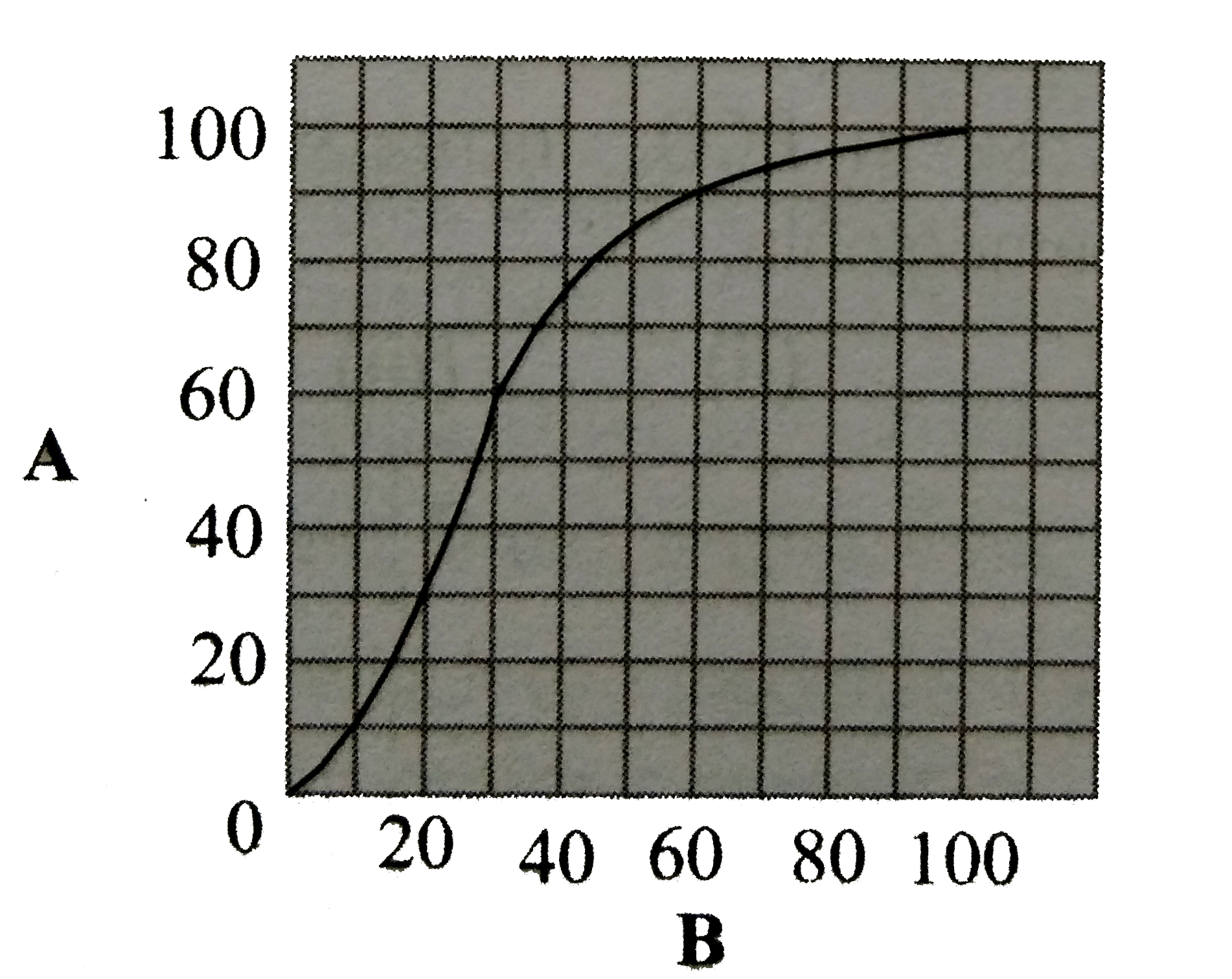 02:26View Solution
02:26View SolutionThe given graph shows an oxygen dissociation curve for haemoglobin.
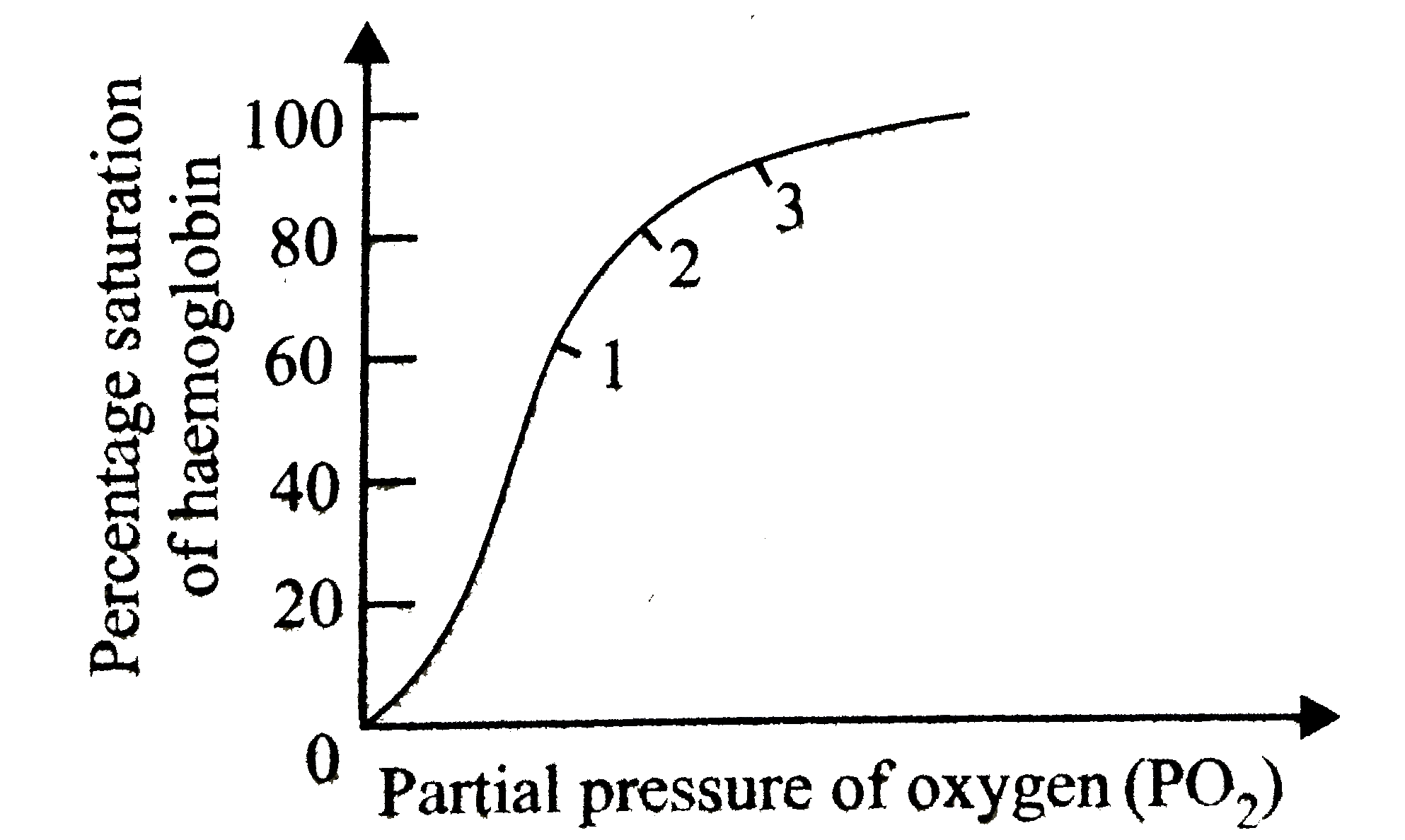
Wher is the body will haemoglobin be saturated at the percentage shown at point `1,2` and `3` in graph ?04:46View SolutionWhen temperature decrease, oxy-Hb curve becomes
View SolutionWhich of the following factors is not favourable for the formation of oxyhaemoglobin ?
View SolutionConsider for following four statements and select the correct option starting which ones are true `(T)` and which ones are flase (F).
(i) Expiration is normally brough about by the relaxation of inspiratory muscles.
(ii) Oxyhaemoglobin can hold much less carbon dioxide in the form of carbaminohaemoglobin than what deoxyhaemoglobin can.
(iii) A person can expel all the air from the lungs by a forceful expiration.
(iv) A rise in `PCO_(2)` increases the oxygen-affinity of haemoglobin.View SolutionAfter taking a long deep breath we do not respire for some seconds due to
View SolutionA large proportion of oxygen remain unused in the human blood even after its uptake by the body tissues. This `O_(2)`
View SolutionIn the tissues, high concentrations of carbon dioxide
View SolutionFetal haemoglobin has X affinity for oxygen than that of mother's haemoglobin during gestation. X is
View SolutionStatement 1 : About `70%` of `CO_(2)` that enters `RBCs` changes into `HCO_(3)^(-)` for transport in plasma to the lungs where it reconverts into `CO_(2)` for elimination.
Statement 2 : About `40%` of `CO_(2)` that enters `RBCs` changes into carbaminohaemoglobin which releases `O_(2)` in the lungs.02:07View SolutionMatch column I with column II and select the correct option from the codes given below.
`{:(,"Column I",,"Column II"),(A.,"Tracheoles",(i),"Yeast"),(B.,"Carbonic anhydrase",(ii),"Fish"),(C.,"Lactic acid",(iii),"Inspiration"),(D.,"Fermentation",(iv),"Vital capacity"),(E.,"Gill filaments",(v),"Fast muscle"),(F.,"Cutaneous respiration",(vi),"Insert"),(G.,"Diaphragm",(vii),"Bicarbonates"),(,,(viii),"Earthworm"):}`View SolutionThe enzyme that increases the reaction rate between `CO_(2)` and `H_(2)O` in red blood cell is
02:01View SolutionWhich of the following equations is correct ?
01:47View SolutionPeople living at sea level have around `5` million RBC per cubic millimetre of their blood whereas those living at an altitude of `5400` metres have around `8` million. This is because at high altitude.
01:59View SolutionDuring `CO_(2)` transport, `HCO_(3)^(-)` diffuses from erythrocytes to plasma and in turn upsets the ionic balance momentraily. In order to keep the ionic balance, an equal number of `Cl^(-)` pass into the erythrocyes from plasma. The process is known as
02:18View SolutionIdentify the correct statement with reference to transport of respiratory gases by blood.
02:06View SolutionWhich of the following is ture for `CO_(2)` concentration ?
View SolutionIn humans which of the following is not a step in respiration?
03:22View SolutionAlthough much `CO_(2)` is carried in blood, yet blood does not become acidic, because
03:27View SolutionHaldane effect plays more important role in promoting carbon dioxide tranport than that of the Bhr's effect in promoting oxygen trasnport because
View SolutionDuring rest, the metabolic needs of the body are at their minimum. Which of the following Is indicative of this situation ?
02:13View SolutionMatch column I with column II and select the correct option from the given codes ?
`{:(,"Column I",,"Column II"),(A.,"Trachea",(i),PO_(2)"in alveolar air"),(B.,"Respiratory centre",(ii),"ATP"),(C,"Yeast",(iii),"Cartilaginous rings"),(D.,"Insects",(iv),"MEdulla oblongata"),(E.,"Fish",(v),"Larynx"),(F.,"Biologically useful energy",(vi),"Tracheal respiration"),(G.,100 "mm Hg",(vii),"Ethanol"),(H.,"Vocal cords",(vii),"Branchial respiration"):}`05:43View SolutionPneumotaxic centre which can moderate the funcations of the repiratory rhythm centre is present in
02:56View SolutionMatch column I with column II an select the correct option from the codes given below.
`{:("Column I",,"Column II"),("A. " underset("heamoglobin")("Carbomino-"),,"(i) Inspiration"),("B. Diaphragm",,"(ii) Hamburger's phenomenon"),("C. Larynx",,"(iii) " underset(" RBC ")("Diffusion of " Cl^(-) "into")),("D. Pons varolii",,"(iv) Carbon dioxide"),("E. Chloride shift",,"(v) Cartilages"),(,,"(vi) Pneumotaxic centre"),(,,"(vii) Expiration"):}`04:02View SolutionChemosensitive area of respiratory centre in medulla is affected by
01:26View SolutionFill up the blanks in the following paragraph by selecting the correct option.
Human beings have a significant ability to maintain and moderate the respiratory rhythm to suti the demands of the body tissues. This is done by the neural system. A specialised centre present in the medulla region of the brain called `overset((i))"_______"` is primarily responsible for this regulation. Another centre present in the pons region of the brain called `overset((ii))"_______"` can moderate the functions of the repiratory rhytm cenre. Neutral signal from this cenre cen reduce the duration of `overset((iii))"_______"` and thereby alter the respiratory rate. A `overset((iv))"_______"` is situated adjacent to the rhythm centre which is highly sensitive to `CO_(2)` and hydrogen ions.View SolutionRate of breathing is controlle mainly by
01:27View SolutionThe respiratory centre in the brain is stimulate by
01:22View SolutionComplete the following sentence by selectrin the correct option.
Receptors associtated with aortic arch and carotid artery can recognise changes in `overset((i))"______"` and `overset((ii))"______"` concentration and send necessary signals to `overset((iii))"______"` for remedial actions.01:35View SolutionComplete the follwing sentence by selectring the correct option.
the breathing rhythm is geneerated in the `overset((i))"______"` and is influenced by variation in levels of `overset((ii))"______"` in the blood.01:31View SolutionWhen `CO_(2)` concentration in blood increases breathing becomes
01:24View SolutionStatement I : Rate of breathing is regulated is regulated by respiratory centres present in the medulla oblongata.
Statement 2 , Changes in the `CO_(2)` level of the arterial blood control the rate of breathing.01:51View SolutionRead the following four statement (i) - (iv) with certain mistakes in two of them.
(i) A water breather expends much more energy in ventilating its respiratoru surface than an air-breathing one.
(ii) Lungs become empty after forceful expiration.
(iii) Exchange of gases in the lungs are interrupted during expiration.
Respiratory movement are controlled by `CO_(2)` concentration of arterial blood.
Which of the above two statements have mistakes ?View SolutionHuman beings have a significant ability to maintain and moderate the respiratory rhythm to suit demands of the body. For it we have
Respiratory rhythm centre in medulla -R
Pneumotaxic centre in pons -RT
Chemosentsitive area in medulla -`C_(1)`
Peripheral chemoreceptors in aortic arch and carotid artery -`C_(2)`
Find out the correct path for regulation of respiration.View SolutionThe urge to inhale in humans results from
02:49View SolutionRead the following four statement carefully.
(i) Ventral respiratory group of neurons of medulla oblongata can cause both inspiration and expiration.
The part of the respiratory and expiration.
(ii) The part of the respiratory system starting with the external the respiratory or exchange part of the respiratory system.
(iii) During swallowing epiglottis can be covered by a thin elastic cartilaginous flap called glottis to prevent the entry of food into the larynx.
(iv) Binding of oxygen with haemoglobin in primarily related of oxygen with haemoglobin is primarily related to partial prssure of `O_(2)`.
Which of the above two statement are correct ?View SolutionEmphysema is a condition resulting from
02:02View SolutionWhich one of the following is the incorrect statement for respiration in humans ?
02:42View SolutionGiven below are few respiratory disorders. Identify occupoational respiratory disorders among these.
(i) Coryza , (ii) SARS
(iii) Silicosis , (iv) Asbestosis
(v) Emphysema04:47View SolutionWhich of the following statements is correct ?
02:42View SolutionFollowing are few characters of a disorder from the choices give below.
View SolutionVisiting high mountains may cause altitude sickness in men living in plan areas. Prime of this is
02:25View SolutionCarbon monoxide can kill a person because of it's extermely high affinity for
02:07View SolutionThe toxic effect of carbon monoxide is due to its greater affinity for haemoglobin as compared to oxygen approximately by
04:46View SolutionBlood analysis of a patient reveals an ususually high quantity of carboxyhaemoglobin content. Which of the following conclusions is most likely to be correct ?
01:53View SolutionDuring winter a person died during sleep, the room was closed and a container with burnt charcoal was found in the room. What may be the possible reason of his death ?
04:38View Solution
Breathing And Exchange Of Gases questions and complete solutions for chapter BREATHING AND EXCHANGE OF GASES of MTG BIOLOGY (HINGLISH) of Class 11
